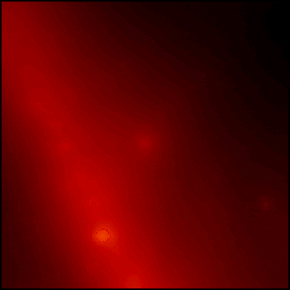 Ten-hour timelapse of GRB 221009A, as seen by the Fermi Gamma-ray Space Telescope | |
| Event type | Gamma-ray burst |
|---|---|
| Date | c. 1.9 billion years ago (detected 9 October 2022) |
| Duration | 10 minutes |
| Instrument | Swift and Fermi Gamma-ray Space Telescope |
| Constellation | Sagitta |
| Right ascension | 19h 13m 03.48s |
| Declination | +19° 46′ 24.6″ |
| Distance | c. 2.4 billion ly |
| Redshift | 0.151 |
| Other designations | Swift J1913.1+1946 |
| | |
GRB 221009A was an extraordinarily bright and very energetic gamma-ray burst (GRB) jointly discovered by the Neil Gehrels Swift Observatory and the Fermi Gamma-ray Space Telescope on October 9, 2022. The gamma-ray burst was ten minutes long,[1] but was detectable for more than ten hours following initial detection.[2][3] Despite being around 2.4 billion light-years away, it was powerful enough to affect Earth's atmosphere, having the strongest effect ever recorded by a gamma-ray burst on the planet.[4][5][6][7][8] The peak luminosity of GRB 221009A was measured by Konus-Wind to be ~ 2.1 × 1047 W and by Fermi Gamma-ray Burst Monitor to be ~ 1.0 × 1047 W over its 1.024s interval.[9] A burst as energetic and as close to Earth as 221009A is thought to be a once-in-10,000-year event.[10][9] It was the brightest and most energetic gamma-ray burst ever recorded, with some dubbing it the BOAT, or Brightest Of All Time.[9][11][12][13]
- ^ Cite error: The named reference
:21was invoked but never defined (see the help page). - ^ Dichiara, S.; Gropp, J. D.; Kennea, J. A.; Kuin, N. P. M.; Lien, A. Y.; Marshall, F. E.; Tohuvavohu, A.; Williams, M. A.; Neil Gehrels Swift Observatory Team (2022). "Swift J1913.1+1946 a new bright hard X-ray and optical transient". The Astronomer's Telegram. 15650: 1. Bibcode:2022ATel15650....1D. Archived from the original on October 14, 2022. Retrieved October 14, 2022.
- ^ Starr, Michelle (October 12, 2022). "Scientists Just Detected a Colossal Gamma-Ray Burst, And It's a Record-Breaker". ScienceAlert. Archived from the original on May 28, 2023. Retrieved October 14, 2022.
- ^ Cite error: The named reference
:15was invoked but never defined (see the help page). - ^ Piersanti, Mirko; Ubertini, Pietro; Battiston, Roberto; Bazzano, Angela; D'Angelo, Giulia; Rodi, James G.; Diego, Piero; Zeren, Zhima; Ammendola, Roberto; Badoni, Davide; Bartocci, Simona; Beolè, Stefania; Bertello, Igor; Burger, William J.; Campana, Donatella (November 14, 2023). "Evidence of an upper ionospheric electric field perturbation correlated with a gamma ray burst". Nature Communications. 14 (1): 7013. Bibcode:2023NatCo..14.7013P. doi:10.1038/s41467-023-42551-5. ISSN 2041-1723. PMC 10646044. PMID 37963921.
- ^ Voshchepynets, Andrii; Agapitov, Oleksiy; Wilson, Lynn; Angelopoulos, Vassilis; Alnussirat, Samer T.; Balikhin, Michael; Hlebena, Myroslava; Korol, Ihor; Larson, Davin; Mitchell, David; Owen, Christopher; Rahmati, Ali; Analysis, Department of System; Theory, Optimization; University, Uzhhorod National (2023). "Multi-Point Detection of the Powerful Gamma Ray Burst GRB221009A Propagation through the Heliosphere on October 9, 2022". arXiv:2309.05856 [astro-ph.HE].
- ^ Crane, Leah (October 17, 2022). "Astronomers have just watched the most powerful explosion ever seen". New Scientist. Archived from the original on October 12, 2023. Retrieved September 29, 2023.
- ^ Cite error: The named reference
:14was invoked but never defined (see the help page). - ^ a b c Burns, Eric; et al. (2023). "GRB 221009A: The BOAT". The Astrophysical Journal Letters. 946 (1): L31. arXiv:2302.14037. Bibcode:2023ApJ...946L..31B. doi:10.3847/2041-8213/acc39c. S2CID 257219686.
- ^ Reddy, Francis (March 28, 2023). "NASA Missions Study What May Be a 1-In-10,000-Year Gamma-ray Burst". NASA. Archived from the original on September 23, 2023. Retrieved March 29, 2023.
- ^ Ionescu, Andrei (June 11, 2023). "Recent gamma-ray burst was 70 times brighter than any cosmic explosion". Earth.com. Archived from the original on September 29, 2023. Retrieved September 17, 2023.
- ^ Lincoln, Don (June 13, 2023). "Explaining GRB 221009A, the greatest cosmic explosion humanity has ever seen". Big Think. Archived from the original on September 29, 2023. Retrieved September 17, 2023.
- ^ Cite error: The named reference
:22was invoked but never defined (see the help page).